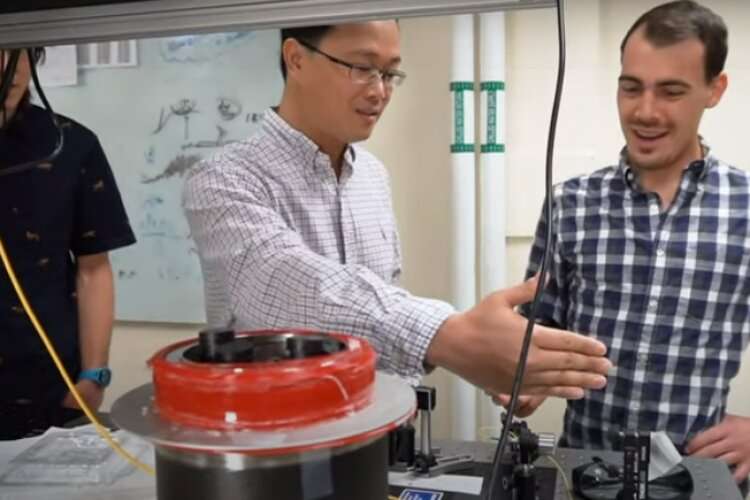Huang (left) and a graduate student discuss a project in their lab. Credit: University of Colorado at Boulder
It is sometimes said that science is about truth, while engineering is about compromise.
With one laser project in his lab in the University of Colorado's Department of Electrical, Computer and Energy Engineering, Shu-Wei Huang and his team are working on a compromise in order to find new applications for a powerful new technology and make it easier to commercialize.
As they looked at the innovative and extremely precise dual-comb spectroscopy being honed by mechanical engineering Associate Professor Greg Rieker and others, Huang's team saw an opportunity to expand its applications.
"We've been trying to see whether we can compromise the performance a little bit to greatly simplify the architecture," Huang said. "The application that we are especially interested in is the biomedical application because in biomedical applications, you don't need the same resolution you need to do something like methane detection."
The result is the counter-propagating all-normal dispersion (CANDi) fiber laser, which won Bowen Li, a postdoctoral researcher in Huang's lab, an award from Optica in 2021.
The key has been a redesigned laser cavity that allows for light to travel both clockwise and counterclockwise, which essentially makes two lasers out of one laser cavity. That, in turn, decreases the number of complex electronics needed to configure two lasers in dual-comb devices, Huang explained.
"We reduce the complexity in the laser design, and we have to compromise the precision a little bit, but it's still much better than the state of art tools used in biomedical applications," Huang said.
In the team's most recent Optica paper, they introduced new techniques to reduce the CANDi laser's relative timing jitter, further proving that the laser will be a good option for a host of applications. That work won Ph.D. student Neeraj Prakash a best poster award at Optica's 2021 Laser Congress.
Huang said they've been working with a startup company in Taiwan that is interested in using CANDi for terahertz imaging—often used in screening for security and drugs. A lab at Colorado State University is also experimenting with the laser for Raman spectroscopy, which has applications in pharmaceuticals and water-quality monitoring.
"CANDi is a new fiber laser architecture and right now, we are working on several projects to unveil its full potential for dual-comb applications," Huang said.
More information: Neeraj Prakash et al, Relative timing jitter in a counterpropagating all-normal dispersion dual-comb fiber laser, Optica (2022). DOI: 10.1364/OPTICA.458339
Bowen Li et al, Bidirectional mode-locked all-normal dispersion fiber laser, Optica (2020). DOI: 10.1364/OPTICA.396304
Journal information: Optica
Provided by University of Colorado at Boulder
























